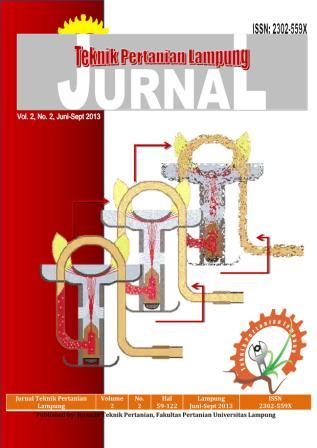DESIGN OF SOLAR THERMAL COLLECTOR TOOL WITH THERMOSIFON SYSTEM
Abstract
Limited availability of fossil energy requires us to find for alternative energy to meet our needs. Solar thermal collector with thermosifon system is one of environmentally friendly alternative energy. The thermosifon system is a natural pump which work based on density difference between cool water and hot water, so that no electric pump is needed. The purpose of this research was to create a mean of collecting solar thermal energy with thermosifon system. The research steps consist of designing, manufacturing, and testing. Thermal collector was made with dimension of 1,5 m long, 1,0 m wide and 1,0 m high, with storage tank capacity of 20 lt. Collector testing was conducted by putting the equipment at an open space from a clock 08:00 − 16:00. It was found that the highest efficiency of solar collector (11,2 %) occurred on July 11, 2012 with an average solar intensity of 756 W/m2, where as the lowest efficiency (8,8 %) occurred on July 7, 2012, with the average solar intensity 479 W/m2. The highest average temperature of the storage tank was 44,7 °C on July 13, 2012 while the lowest average temperature was 35,3 °C on July 12, 2012.
Keywords: Solar Collector, Thermosifon, Radiaton Intensity, Thermal Efficiency
Downloads
Published
Issue
Section
License
- Authors who publish with this journal agree to the following terms:
- Authors retain copyright and grant the journal right of first publication with the work simultaneously licensed under a Creative Commons Attribution-ShareAlike 4.0 International Lice that allows others to share the work with an acknowledgement of the work's authorship and initial publication in this journal.
- Authors are able to enter into separate, additional contractual arrangements for the non-exclusive distribution of the journal's published version of the work (e.g., post it to an institutional repository or publish it in a book), with an acknowledgement of its initial publication in this journal.
- Authors are permitted and encouraged to post their work online (e.g., in institutional repositories or on their website) prior to and during the submission process, as it can lead to productive exchanges, as well as earlier and greater citation of published work (See The Effect of Open Access).
Jurnal Teknik Pertanian Lampung

JTEPL is licensed under a Creative Commons Attribution-ShareAlike 4.0 International License.

